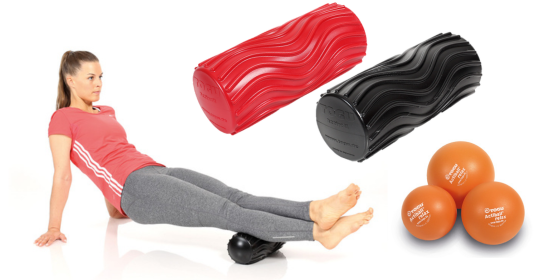Fasciae are the connective tissues that surround muscles, bones and organs in the body. If they are healthy, they are elastic, supple, strong and resilient. However, various factors such as overuse, lack of exercise, inflammation, scars or the aging process can lead to agglutinated fasciae. Learn in this article how you can make your fascia healthy and resilient again with fascia therapy and fascia exercises.
What is fascia therapy?
Fascia therapy is a special type of therapy that aims to improve the health of the fascia in the body. Various techniques are used to loosen and mobilize agglutinated or hardened fascia. For example, special massage techniques, stretching exercises or the use of fascia rollers or balls can be used for this purpose.
Fascia therapy is often used for pain and tension, especially in the back, neck and shoulders. It can also be used for sports injuries or injury prevention. The goal of fascia therapy is to improve the health of the fascia and thereby reduce pain and restricted movement.
What is the importance of healthy fascia for health?
Healthy fasciae are of great importance for health, as they are an important part of the connective tissue in the body and perform numerous functions. Fasciae give shape and structure to the body, surround and protect muscles, organs and bones. They are also responsible for the transmission of forces and the coordination of movements in the body. In addition, they contribute to the stability and flexibility of the body and ensure that the layers of tissue glide smoothly during movements.
When fasciae become stuck or hardened, it can lead to pain, restricted movement and tension. This, in turn, can have an impact on physical health and well-being. Fascia therapy and fascia fitness can help improve fascia health, reducing pain and movement restrictions.
What is fascia fitness?
Fascia fitness describes the state of health, flexibility and performance of our fasciae. Ideal fascial fitness means supple fascia that leads to better posture, increased mobility, performance and less pain. Fascia therapy is one of the most important ways to achieve and maintain fascial fitness.
How can fascia training help?
Fascia training can help improve fascia health in a number of ways, thereby reducing pain and limited range of motion. Some of the benefits of fascial training are:
- Improved Elasticity: Targeted stretching and training of the fascia will improve your elasticity, leading to greater mobility and flexibility.
- Improved circulation: Fascia training can improve circulation in the body, which can help reduce tension and pain.
- Reduced adhesions: Adhesive fascia can lead to pain and limited range of motion. Fascia training can help to reduce these adhesions and thus improve the mobility of the fascia and flexibility of the body.
- Improved posture: Poor posture can lead to tension and pain. Targeted fascial training can correct muscle imbalances and improve posture.
- Reduced susceptibility to injury: Improved mobility, flexibility and stability of the fascia can reduce susceptibility to injury.
Overall, fascial training can help improve fascial health and thus reduce pain and limited range of motion. It can be an important component of a holistic training approach aimed at improving physical health and fitness.
Fascia exercises for tightened fasciae
To keep fascia healthy, it should be exercised 1-3 times a week. Fascia exercises should complement muscle building, endurance and coordination training. It is important not to overload the body and feel yourself. Warming up should be done before training to avoid strains and injuries. It takes several months before the first results of a supple and strong connective tissue are noticed. The perception of the body is important to train the so-called “6th sense”. This is because there are numerous sensory receptors and sensitive nerves between the individual tissue layers.
Rebound elasticity
This exercise is designed to activate the elastic fibers for movement. Swings with low weights should be performed with a slight bias in the opposite direction to take advantage of the catapult effect and spring back elastically. This dynamically releases the stored energy, comparable to cocking and releasing an arrow in archery. The whole body tension is always maintained!
TIP: Move quietly to perform the exercises correctly!
Fascia stretch
This exercise is designed to build up a “young collagen structure” by regularly stretching the fasciae. Soft, elastic, cat-like movements in long myofascial chains should be performed. Angles in the direction of movement should be repeatedly changed and twisted in a spiral.
Fascia release and hydration
This exercise dissolves so-called “cross links” (tangles of tissue structures) to restore an elastic and flexible fibrous structure. Back-and-forth movements should be performed slowly and a so-called “feel-good” pain should be felt. The tissue is naturally moisturized and the gliding ability of the different tissue layers is improved.
Sensory Refinement
Sensory Refinement refers to improving and refining the ability to perceive sensory stimuli, especially through physical movement and activity.
For example, a typical exercise for Sensory Refinement is balancing on an unstable surface such as a wobbly cushion or unstable platform. By balancing the body on an unstable surface, sensory receptors in the feet, legs, and body are activated and stimulated to achieve a finer and more accurate perception of balance.
Our TOGU experts advise
Incorporate regular targeted fascia strengthening and stretching exercises into your workout routine – A great way to mobilize and loosen connective tissue is to use a fascia roller or massage ball. This will help you release tension and improve circulation in the tissues. The important thing here is not to go too fast and to get used to the intensity slowly to avoid injury. Regular use can help increase mobility and relieve pain in the fascia. Try it and you will quickly feel positive effects!
These products from TOGU might interest you:
Dynair® Ballkissen ® 30cm – red
Dynair® Keil Ballkissen® Premium – misty mountain
Faszio Ball local – local approx. 4 cm

